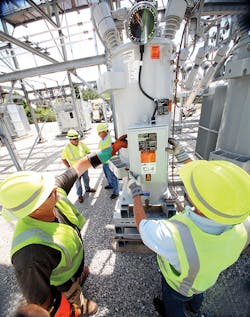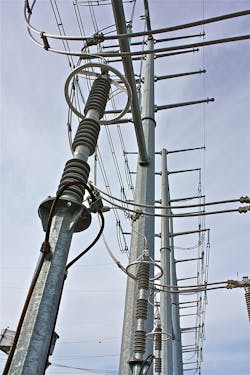With mounting pressure from the Illinois legislature, special interest groups and consumers to increase the state’s renewable energy portfolio, the Illinois Commerce Commission initiated the NextGrid study in 2017 to assess grid modernization initiatives in the state of Illinois, U.S. One objective of the study was to evaluate the way in which the state’s electric utilities could incorporate more distributed energy resources (DER) and the effect these additional grid assets would have on rates and revenue models. One key factor that would help to assess the value and siting of DER is more accurate and locational load forecasting, including forecasting locational system losses and distributed unaccounted for energy (DUFE).
This analysis would require Ameren Illinois to collect much more granular, temporal and spatial data—not only from DER generation assets but also from millions of other grid assets continually changing in response to DER adoption and energy-efficiency programs. Ameren already had begun developing several bottom-up forecasting projects prior to the Illinois Commerce Commission’s study requests. The forecast models for these projects were created using the PowerRunner Energy Platform, an enterprise application platform with a configurable big-data fabric layer that joins and delivers highly granular operational technology and information technology utility data in real time to support an enterprise data virtualization platform.
One of the projects Ameren Illinois fast-tracked to support the NextGrid study objectives was a new methodology to conduct a system loss analysis followed by a recently completed real-time loss (RTL) program. Approved by the Illinois Commerce Commission, the RTL methodology went into effect on June 1, 2018. Since May 31, 2018, the Ameren Illinois RTL program has been publishing day-ahead forecasts for the distribution loss factors by voltage (loss) class for each hour. This look-ahead forecasting of distribution losses will help the utility and competitive retail energy suppliers by providing day-ahead hourly distribution losses and unaccounted for energy in a more accurate, transparent manner.
New Approach to Old Problem
According to the U.S. Energy Information Administration (EIA), distribution system losses account for more than US$19 billion annually in real physical losses and unaccounted for energy. These losses are factored into the risk premium that energy marketers and load-serving utilities pass on to customers. This problem is further compounded by the traditional top-down models for calculating these losses, which are little more than generalized statistics based on an annual hourly system peak load. While the top-down approach may have been adequate when the grid looked pretty much the same year to year, shifts in population and workplace demographics combined with growing DER mean a top-down system-loss analysis (SLA) study model can become obsolete in just months.
Top-down methodologies were built on the assumption downstream assets change very little over time and are homogeneous. For example, the behavior of a home with an air conditioning load at a certain temperature would be predictable over a long period of time. Since one home with an air conditioner looks like every other home with an air conditioner (except for variations in size), they should be homogenous in how they behave. The idea of treating all those loads as one big load was adequate from an accuracy standpoint because each pretty much looked the same and their electricity use changed little over time.
However, those assumptions are no longer valid because every home no longer looks and behaves in essentially the same way, especially when taking into consideration the consumer adoption of solar panels and electric vehicles. In any given home, one day now looks very different from another day and from other homes, depending on how much solar power and electric vehicle charging are used. In addition, some homes may now use energy storage, convert from traditional heating and cooling to heat pumps, or use other energy-efficiency technologies. Trying to model a system that treats everything the same no longer works.
A Better Approach
Ameren Illinois decided there had to be a better way, particularly with driving additional value from recent investments in advanced metering infrastructure (AMI). When the system-wide deployment of AMI neared completion, the utility had hourly data for more than 75% of its service points, which could be segmented easily by voltage (loss) class.
The utility already had all this historical AMI data as well as monthly metered service-point data in the PowerRunner Energy Platform. It built on this foundational data virtualization platform and extended the PowerRunner micro-forecasting application to create unique hourly day-ahead load forecasts for all service points in its Illinois service territory and corresponding five-day loss factor forecasts by voltage class.
This bottom-up approach leverages historical AMI data to model each service point as a unique asset. As PowerRunner continually consumes data related to these assets, machine-learning self-tuning algorithms adjust the forecast models for more than 1.4 million assets to improve hourly forecast accuracy continually.
Big-Data Solution
DUFE is the electricity injected into the system each hour that is not consumed by customers or attributable to technical system losses. Examples of sources of DUFE include theft, orphan meters and profiled scalar meter error. Historically, DUFE was assigned to customers without interval metering (scalar metered customers) because, as utilities logicized, they knew exactly how much power and energy an interval metered customer used each hour but did not know how much power customers without interval meters used hour by hour. Even knowing this argument was imperfect, Ameren Illinois and other utilities did not have the granular data needed for every asset to allocate DUFE properly.
With the continued rollout of AMI meters, most customers in the Ameren Illinois service territory will have an interval meter by the end of 2019, yet there will still be some DUFE. What should be done about it? In the past, DUFE was zeroed out each time a loss study was performed. At best, the loss study determined the amount of losses at the time the study was conducted. These values traditionally were used in rate cases, so the utility could recover the full cost of the power it purchased or produced. Over time, DUFE slowly would continue to increase as the system topography changed, load increased and customer load profiles changed.
With AMI data and PowerRunner, this entire cycle—which used to take months or years to prepare—can be repeated every hour on demand. Ameren Illinois now collects AMI data every hour, calculates loss factors by voltage class (in fractions of a second), zeros out DUFE and fully accounts for every unit of power injected into the distribution system. DUFE no longer must be assigned arbitrarily to a particular customer class of a particular customer group with certain types of meters.
For the past 50 years, utilities calculated loss factors by voltage class for a few peak hours of the year. Up until now, Ameren Illinois and other utilities have had no way to identify and quantify where losses were occurring by individual circuit, voltage class or time of day. All customers served at a particular voltage were assigned the same loss factor. However, this is not how the system works. Losses also are a function of the physical characteristics of the distribution system (for example, the transformers, wires, length of circuit and number of switching devices).
The losses on one part of the system are not the same as on other parts of the system. In other words, there is a locational characteristic to losses. As more sensors and meters are deployed across the distribution system, the same new real-time loss technique being used to calculate loss factors for each hour by voltage class also could be used to calculate loss factors by location on the system.
Accurate Data Reduces Risk
In the past, energy marketers had no way to predict the magnitude of DUFE, making it difficult for them to create accurate demand bids. Now, Ameren Illinois can forecast day-ahead distribution loss factors and suppliers can forecast their loads more accurately for the days ahead, thus producing more accurate demand bids. Accurate demand bids lead to reduced penalties, reduced risk premiums and, ultimately, savings for customers.
Even during the pilot phase, the Ameren Illinois RTL program began showing dramatic reductions in variances between forecasted and actual day-ahead load forecasts. Right out of the box, without manual intervention from business users, the PowerRunner Energy Platform created system forecasts that reduced the mean absolute percentage error (MAPE) of the forecast-to-actuals variance by more than 30% compared to the incumbent top-down forecasting solution. In the first quarter of operation, the PowerRunner machine-learning algorithms continued to self-tune and further reduced the MAPE by 40% without business user tuning. This continual improvement in day-ahead forecasting translates into more accurate demand bids and less risk for suppliers that should ultimately result in savings for customers.
Transaction-Based Model
The new RTL system is just a starting point for the PowerRunner micro-forecasting solution at Ameren Illinois. As more sensor data and advanced distribution management system supervisory control and data acquisition (SCADA) points become available, Ameren Illinois will be able to perform loss calculations on every single feeder circuit on its distribution system to get a true accounting of where all the kilowatt-hours are going—not just by system voltage class but also by individual circuits.
Combining RTL with an asset-level micro-forecasting engine creates a gateway to a host of strategic initiatives, including locational analysis of the cost of service to determine where power is most valuable at any time of day. It also is the first step toward creating future DER locational pricing models and a guide to determine where utilities need to site new DER or discourage DER, when it contributes marginal or no value to the grid.
Additional near-term value will be created by enabling more accurate asset loading analysis, planning studies and cost-of-service studies using circuit-specific real-time loss calculations. Ameren Illinois believes technology-driven, bottom-up real-time forecasting models will become the new standard for a 21st century transactive energy grid, a business model that could drive the future of the electric utility industry.
Keith P. Hock ([email protected]) is senior director of IT/OT and digital field services at Ameren, where he is responsible for the digital teams supporting Ameren’s transmission, distribution and generation business lines, including the Maximo/geographic information system program and managing emerging talent at the Ameren Innovation Center. Hock has more than 30 years of experience in the utility business and has been with Ameren for more than 25 years. He has experience in nuclear reactor core design, forecasting and rate design, including developing settlement protocols for the Midcontinent Independent System Operator Inc. energy, transmission, capacity, financial transmission rights and auction-revenue rights markets.
For more information:
Ameren | www.ameren.com
PowerRunner | www.powerrunner.com
About the Author
Keith P. Hock
Keith P. Hock is director of transmission technical services and operations planning at Ameren Services, where he is responsible for real-time operations support, short-term planning and providing technology services to the Ameren transmission business line. Hock has more than 30 years of experience in the utility business and has been with Ameren for more than 25 years. He has experience in nuclear reactor core design, forecasting and rate design, including developing settlement protocols for the Midcontinent Independent System Operator Inc. energy, transmission, capacity, financial transmission rights and auction revenue rights markets.



